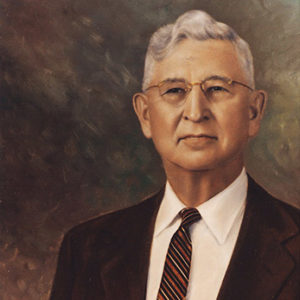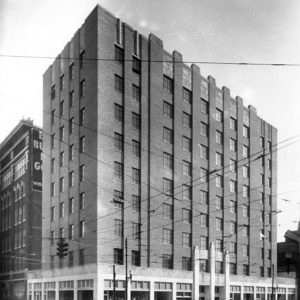calsfoundation@cals.org
Neal Bryant Garver (1877–1969)
Neal Bryant Garver arrived in Little Rock (Pulaski County) in 1918 to help provide engineering services for the construction of a munitions plant during World War I. As the Arkansas State Highway Department’s first bridge engineer, Garver also led the design of more than 2,000 bridges from 1921 to 1950, helping to modernize the state’s roadways by adding river crossings. In 1919, Garver started what became the state’s largest engineering firm, which began by providing structural engineering services for Little Rock High School (later called Little Rock Central High), North Little Rock High School, the Pulaski County Jail, and many other structures.
Neal Garver was born on February 17, 1877, in Lee County, Iowa, near the Mississippi River, to the farming family of Eliza Adelaide Clifford Garver and Jacob Garver, a Civil War veteran from Pennsylvania. His interest in engineering was sparked when he helped cut down oak trees to be used as bridge supports. Despite having only an elementary education, he obtained a teacher’s certificate before attending Highland Park College in Des Moines, Iowa. He later gained admittance to Iowa State University in Ames.
Garver married Laura Scott on December 10, 1905; they had one son and two daughters.
After graduating with a civil engineering degree in 1905, Garver worked for the American Bridge Company in Toledo, Ohio, designing and fabricating steel, some of which was used to rebuild San Francisco, California, following the 1906 earthquake. In 1910, he left for what is now the University of Illinois at Urbana-Champaign to teach structural engineering. In 1918, he informed the engineering firm Alvord and Burdick of Chicago, Illinois, that he was available for war work and was assigned the picric acid project in Little Rock (picric acid is used in making explosives).
Garver and two others working on the project arrived in Little Rock on June 18, 1918, according to his unpublished autobiography. They stayed their first night at the Marion Hotel before finding temporary rooms at a home on 9th Street, where Arkansas Children’s Hospital was later built. When the Armistice was signed in November 1918, signaling the end of the war, construction slowed and eventually stopped. Garver resigned from the University of Illinois to prepare a report on the construction of the plant, after which he decided to stay in Arkansas because he saw a need for structural engineers. “Architects were here in sufficient number to design buildings, but few could design complicated structural features,” he wrote in his autobiography.
Garver’s first office was in the Gazette Building on the corner of 3rd and Louisiana, and his first private engineering project was to develop standard bridge plans for the State Highway Department. He also provided structural engineering plans for a type of cotton warehouse that reduced the likelihood of fire. Garver soon moved to the Donaghey Building on 7th and Main when Governor George Washington Donaghey offered him office space in exchange for engineering work on the building. Later joined by partner W. T. Morrow, Garver provided structural engineering services for Little Rock High School, North Little Rock High School, Dunbar High School, the Pulaski County Jail, the Ben McGehee Hotel, the Gay Building, the 555 Building, the original Immanuel Baptist Church, and the Wallace Building; he also did work on the science, agriculture, and library buildings at the University of Arkansas (UA) in Fayetteville (Washington County).
During the 1930s, Morrow left for work in Tennessee, and Garver devoted more of his time to the Highway Department, serving as chief engineer for two years, but mostly as bridge engineer. Until his retirement from the Highway Department in 1950, Garver consulted on bridge expenditures totaling $75,000,000. His work touched the state’s most significant bridges, including the bridge over the Arkansas River at Dardanelle (Yell County) and the Memphis-Arkansas Memorial Bridge over the Mississippi River in West Memphis (Crittenden County).
Garver served as president of the Rotary Club of Little Rock and was honored with a Doctor of Laws degree conferred by UA in 1948. His son, Mark Garver, became Little Rock’s first traffic engineer in 1952, before partnering with his father in 1954. Garver and Garver was incorporated in 1959.
Neal Garver died on April 23, 1969, in Little Rock, and he is buried at Pinecrest Memorial Park in Little Rock. Following his death, the company he founded went on to deliver such Arkansas projects as Interstate 630; Interstate 540 (later renamed Interstate 49), including the Bobby Hopper Tunnel; and the second incarnation of the Broadway Bridge. By 2017, company had more than 400 employees spread among twenty-three offices in ten states.
For additional information:
Beasley, George. “Neal B. Garver: Arkansas’s Engineer of the Year.” Arkansas Gazette, February 24, 1957, p. 5E.
“Mark G. Garver Takes Double City Job Today.” Arkansas Gazette, January 23, 1952, p. 1B.
“Neal Garver, LR Engineer, Dies at Age 92.” Arkansas Gazette, April 25, 1969, p. 11B.
Thomas, David Yancey, ed. Arkansas and Its People: A History, 1541–1930. Vol. 3. New York: American Historical Society, 1930.
“Warehouse Men Secure Engineer, Builder of Picron [sic] Acid Plant becomes Cotton Association Advisor.” Arkansas Gazette, June 25, 1920, p. 5.
Troy Schulte
North Little Rock, Arkansas
 Early Twentieth Century, 1901 through 1940
Early Twentieth Century, 1901 through 1940 Science and Technology
Science and Technology 555 Building
555 Building  Neal Garver
Neal Garver  Wallace Building
Wallace Building 




Comments
No comments on this entry yet.